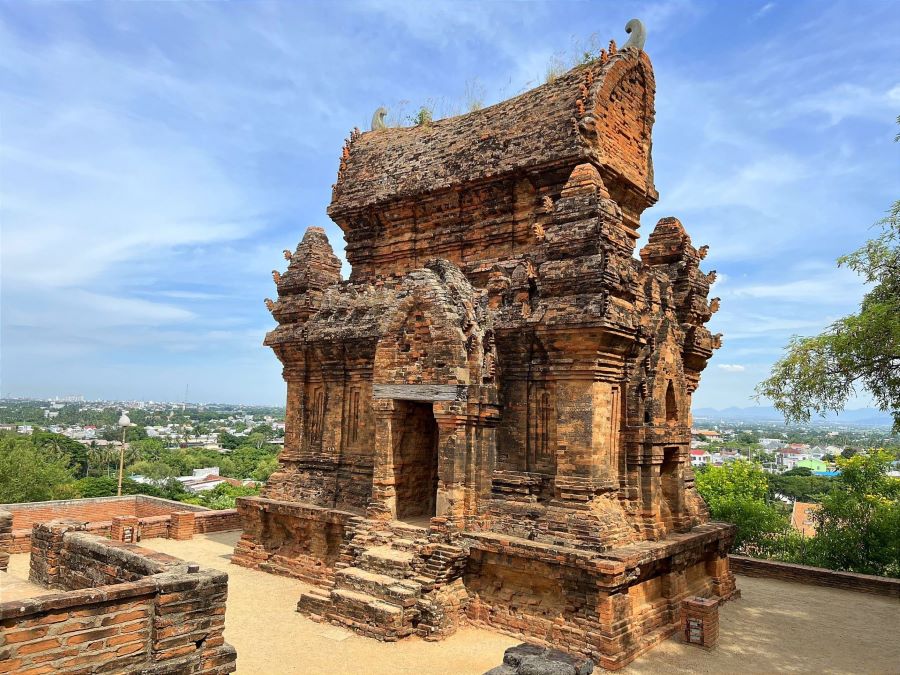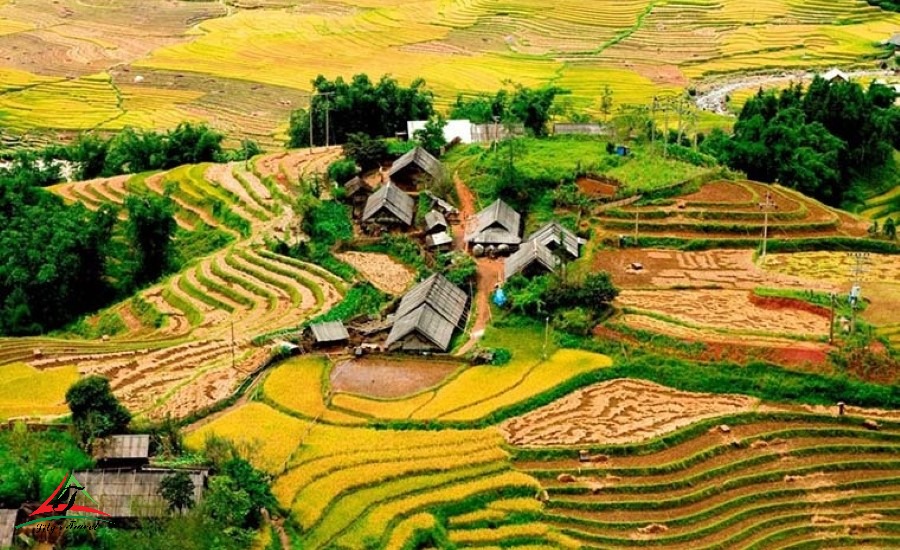Rainy season in Vietnam and things to note during the trip
Travel to Vietnam, many travelers wonder when the rainy season starts in Vietnam. The answer lies in the elongated S-shaped territory of Vietnam, which enjoys the bounty of nature with a variety of different climates, generally varying according to the three regions of the North, Central, and South.
In the Northern region, the rainy season typically extends from May to mid-September. The Central region generally experiences a shorter rainy season from September to February of the following year. As for the South, it will experience rainfall from May to October.
Although heavy rains may seem discouraging, they bring with them an authentic beauty and a refreshing atmosphere. Traveling during this time requires careful preparation to make the most of this contrasting season.
This article will guide you through the essential considerations for traveling to Vietnam during the rainy season.
Overview of the Climate and Explanation of the Rainy Season in Vietnam
Under the tropical influence, Vietnam experiences distinct seasons, among which the rainy season holds a special place. With persistent humidity and a unique climatic rhythm, this country transforms into a lush paradise of greenery and vitality.
Vietnam has a tropical climate in the south and a subtropical climate in the north. In other words, the country is hot and humid almost year-round, with average temperatures ranging from 25°C to 30°C in the summer and 10°C to 25°C in the winter. However, due to its diverse topography, shaped by mountain ranges, plateaus, and plains, Vietnam is distinguished into three main regions, practically correlating with three main types of climates:
- The North, particularly the mountainous areas, experiences a relatively cool and humid climate.
- The South enjoys a warm climate year-round, with seasonal showers.
- The Central coast, characterized by a mild climate, presents two distinct seasons: the rainy season and the dry season.
Therefore, Vietnam’s climate is greatly influenced by the monsoon phenomenon, generally manifesting through rainy periods at different times of the year. Yet, this period offers a unique opportunity to discover Vietnam from a different perspective but also requires careful preparation to fully enjoy its unique charms.
Rainy Season Period in Vietnam
In Northern Vietnam: Mid-May to Mid-September

Rain in Hanoi, northern Vietnam (photo: VTV)
The rainy season in Northern Vietnam starts around May and can end in August or September, depending on the year. Coastal areas can be significantly influenced by hurricanes making landfall. The capital Hanoi and surrounding regions are less affected by storms compared to the northern coastal areas.
Rains are most intense during the summer due to high temperatures and atmospheric humidity. Showers and violent thunderstorms tend to occur in the late afternoon. Or, under the effect of a passing atmospheric depression, rains can last for 2 to 3 consecutive days in the summer (approximately from May to August).
In Central Vietnam: September to February of the Following Year
Rains in Central Vietnam arrive later than in the north, starting in September and ending in February. Seasonal rains in the Central region are frequent, with precipitation reaching up to 3,000 mm. There can be days of continuous, relentless rain.
September and October mark the beginning of the rainy season. The climate in the Central region during this time is generally characterized by slight sunny periods, while afternoons and evenings are slightly cool and rather pleasant.
The climate in the Central region during the rainy season is harsher than in the south and north. Therefore, to fully enjoy your trip, it is recommended to check weather forecasts before departing.
In Southern Vietnam: May to October
Starting in May, when the North enters summer, the South begins to be swept by winds from the Indian Ocean and the Bay of Bengal. This type of wind carries a lot of moisture and easily causes precipitation.
Rainfall in the South is generally not uniform across the entire region. The climate in the South during the rainy season is generally cool, making it the most pleasant time of the year.
Rains in the South often occur very quickly, coming and going in an instant. Rain can fall abundantly, then disappear just as quickly, without lingering from day to day. If you travel to the South during the rainy season, it is advisable to bring an umbrella and a raincoat once you arrive.
Sometimes, the climate in the South can be capricious, with heavy rain in the morning while the afternoon clears up quickly. As the city is bathed in brilliant golden light, a sudden downpour can strike abruptly.
The inhabitants of this region often compare the rainy season in the South to a capricious young girl, difficult to satisfy. If you wish to head to the South during this period, Ho Chi Minh City or Vung Tau are both ideal choices.

Sudden rain in Ho Chi Minh City, southern Vietnam
Advantages of Traveling During This Season
It is not the peak tourist season, so the rainy season brings many advantages to visitors who enjoy new, unusual experiences. The cool weather during the rainy season is ideal for relaxation and leisure trips.
Firstly, there is the comfort of traveling. Tourists won’t have to rush to crowded famous tourist spots but can peacefully enjoy the magnificent scenery, people, and other cultural values.
Additionally, the cost of accommodation and tour services will be much more affordable than during the high season. You won’t have to worry about organizing your schedule for practical visits to destinations but can rather relax and enjoy spontaneously throughout the trip. Services will thus be more attentive, and the places of stay quieter, suitable for leisure moments.
The rainy season may suspend some outdoor activities. However, visits to picturesque alleys or indoor attractions retain their value. Museums, historical monuments, exhibitions, temples, and churches remain open to visitors.
Strolling under the light rain, slipping into a small street-side restaurant, and snuggling in the calm of the city on a rainy day could be an “intimate” and unique experience for a trip to Vietnam.
What to Do in Vietnam During This Season? 3 Best Destinations to Visit
1. Hue
The rainy season in Hue lasts from September to December. Traveling during the rainy season in Hue, visitors will have the opportunity to savor magnificent, poetic landscapes full of emotional depth.

Rain in Hue (photo: Doan Quang)
One of the highlights of Hue is the Complex of Hue Monuments. Under the heavy showers, the landscapes reflect the authentic beauty of an ancient past, taking on a melancholic hue full of memories.
Moreover, in the cool weather made even warmer by the rain, you can enjoy comforting dishes like Hue beef noodle soup or sip tea on the banks of the romantic Perfume River, an unforgettable experience for sure.
2. Da Lat
In early August, the first rains appear, announcing the imminent arrival of the rainy season in Da Lat. The rains in Da Lat last until mid-October, neither abundant nor endless like elsewhere.
The romantic beauty of Da Lat during the rainy season stands out along the roads lined with yellow wildflowers and mimosas, evoking emotions in everyone. This is why many visitors choose to go to Da Lat during the rainy season to discover all the flavors that this mountainous city has to offer.
Some captivating points of interest during a trip in the rainy season to Da Lat include observing Prenn Waterfall, visiting the Da Lat Flower Garden, and the tourist area of the Maple Leaf Forest, among others.
Read more: Top 10 things to do in Da Lat
3. Hoi An
When traveling during the rainy season in Central Vietnam, don’t forget to visit the ancient town of Hoi An. The feeling of sheltering under an umbrella while walking in the rain among the old houses and golden walls, along with rows of colorful lanterns, creates a highly poetic scene.
You can also choose a high place in one of these old houses, enjoy a cup of tea or hot coffee, and contemplate the beauty of Hoi An street under the showers.
If, unfortunately, it rains heavily and Hoi An is flooded, don’t worry. You will also have the chance to enjoy a charming boat ride around the ancient town. During full moon days, Hoi An shines brightly, illuminated by lotus flowers and hanging lanterns everywhere. At that moment, the Hoai River is equally resplendent, captivating everyone’s hearts.
Read more: Hoi An, Vietnam – dream destination for a honeymoon
What to Prepare for Traveling to Vietnam During This Period?

Enjoying coffee and admiring Da Lat in the rain is an experience not to be missed (photo: Hoang Linh Ha)
During the rainy season in Vietnam, showers are generally constant but light. You don’t need to bring rain gear from your country. Indeed, on all the streets in Vietnam, you can easily find vendors selling umbrellas or very light raincoats that cover up to your feet, with a hat at an affordable price. They dry quickly and can be rolled up to fit in your pocket.
As for shoes, you should prepare in advance or buy shoes that can repel water and dry quickly, with soles equipped with grooves to prevent slipping.
How to Avoid the Rainy Season in Vietnam?
First, the easiest way to avoid the rainy season in Vietnam is to plan your trip during the dry season, from October to June. If you cannot travel during these dates, do not worry excessively, but rather adapt gradually to this weather so as not to disrupt the enjoyment of your trip.
Feel free to leave your comments below or contact Paradise Travel directly for quick assistance from our team of consultants. We will help you design the best itinerary for all times of the year. This will allow you to fully enjoy this beautiful region of Southeast Asia without fearing the rain or the sun.
You can travel safely thanks to our experienced drivers, who have extensive experience driving in various weather conditions.
We hope this article has provided you with the necessary information for traveling during the rainy season in Vietnam. Have a great trip!
Read more: 13 must-do activities when visiting Vietnam
Start planning your tailor-made Vietnam tour by contacting one of our specialists…







